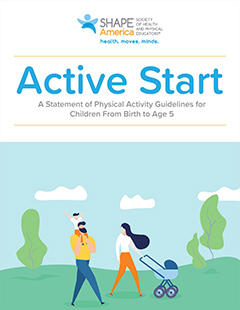Active Start

Members: FREE
Non Members: $15.00
Please contact [email protected]
to obtain this e-book.
Active Start: A Statement of Physical Activity Guidelines for Children From Birth to Age 5, 3rd Edition
All children from birth to age 5 should engage in daily physical activity that promotes movement skillfulness and foundations of health-related fitness.
SHAPE America has updated and revised this national guidelines document to address the physical activity needs of children from birth to age 5. This new edition complements other current national consensus documents addressing physical activity recommendations for children birth to age 5, and it incorporates new information found in research studies. The document also offers the reader an expanded list of activities to implement with a particular age level. It is SHAPE America’s goal to give all children from birth to age 5 an active and healthy start to developing lifelong habits of daily physical activity. The 2020 recommendations in this document are intended to highlight the responsibility of adults who interact with infants, toddlers and/or preschoolers to promote movement and motor competency and establish healthy patterns of physical activity and exploration of the physical environment. In turn, those experiences can enhance children’s overall physical, cognitive, and social development.
The book provides five national guidelines for each age category: infants (birth to age 12 months), toddlers (age 12 to 36 months), and preschoolers (ages 3 to 5). The guidelines answer questions about kinds of physical activity, the activity’s environment and the people responsible for facilitating the physical activity.
Explanations and discussion of typical activities accompany the listing of the guidelines. Also included: a Frequently Asked Questions section, a glossary of terms and an expanded, comprehensive list of background resources.
SHAPE America's National Guidelines for Infants
-
Guideline 1: Infants should interact with caregivers in daily physical activities that are dedicated to exploring movement and the infants’ environment.
-
Guideline 2: Caregivers should place infants in settings that encourage and stimulate movement experiences and active play for short periods of time several times each day.
-
Guideline 3: Infants’ physical activity should promote their development of movement skills.
-
Guideline 4: Whenever possible, caregivers should ensure an environment for infants that meets or exceeds recommended safety standards for performing large-muscle activities.
-
Guideline 5: Those responsible for infants’ well-being are responsible for understanding the importance of physical activity and promoting movement skills by providing opportunities for structured and unstructured physical activity.
SHAPE America's National Guidelines for Toddlers
-
Guideline 1: Toddlers should engage in a total of at least 30 minutes of structured physical activity each day.
-
Guideline 2: Toddlers should engage in at least 60 minutes − and up to several hours − per day of unstructured physical activity and should not be sedentary for more than 60 minutes at a time, except when sleeping.
-
Guideline 3: Toddlers should develop movement skills that will serve as the building blocks for future motor skillfulness and physical activity.
-
Guideline 4: Whenever possible, caregivers should provide toddlers with indoor and outdoor areas that meet or exceed recommended safety standards for performing large-muscle activities.
-
Guideline 5: Those in charge of toddlers’ well-being are responsible for understanding the importance of physical activity and promoting movement skills by providing opportunities for structured and unstructured physical activity and movement experiences.
SHAPE America's National Guidelines for Preschoolers
-
Guideline 1: Preschoolers should accumulate at least 60 minutes of structured physical activity per day.
-
Guideline 2: Preschoolers should engage in at least 60 minutes − and up to several hours − of unstructured physical activity per day and should not be sedentary for more than 60 minutes at a time, except when sleeping.
-
Guideline 3: Preschoolers should develop competence in fundamental movement and motor skills that will serve as the building blocks for more advanced physical activity.
-
Guideline 4: Whenever possible, caregivers should provide preschoolers with indoor and outdoor areas that meet or exceed recommended safety standards for performing large-muscle activities.
-
Guideline 5: Those in charge of preschoolers’ health and well-being are responsible for understanding the importance of physical activity and promoting movement skills by providing opportunities for structured and unstructured physical activity.
Acknowledgements
SHAPE America extends its appreciation to members of its
Active Start Committee and the Active Start Revision Task Force for contributing their time and effort
to developing and expanding upon the content of this document.
Revision Task Force (authors of the 3rd Edition, 2020)
Stephen J. Virgilio, Rhonda Clements
Revision Task Force (authors of the 2nd Edition, 2009)
Jackie Goodway and Nancy Getchell
Active Start Committee (authors of the 1st Edition, 2002)
Jane E. Clark (Chair),
Rhonda L. Clements, Marci Guddemi, Don W. Morgan,
Rae Pica, James M. Pivarnik,
Mary Rudisill,
Eric Small, Stephen J. Virgilio
© 2020, SHAPE America All rights reserved.
Reproducing this work in any form by any electronic, mechanical or other means – including photocopying or storage in any information-retrieval system – is expressly forbidden without written permission from the publisher. To request permission to reprint or copy portions of this work, visit www.shapeamerica.org/permissions.